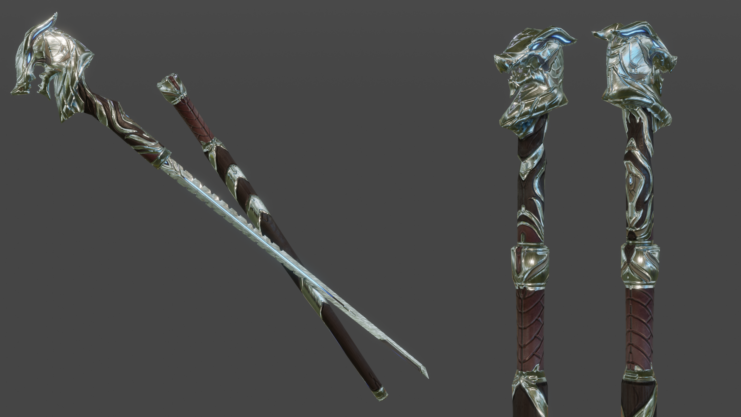From the lurid worlds of adventure novels to the historical dramas on television, one item has consistently captured our imagination: the cane sword. It’s an object that is, at once, both debonair and dangerous—a gentleman’s walking stick that conceals a deadly secret. But how much of this is Hollywood fantasy, and how much is rooted in historical fact? Were cane swords ever really a thing?
What is a Cane Sword?
A cane sword, also known as a swordstick, is a concealed weapon that appears to be a walking cane but contains a hidden blade inside its shaft. Essentially, it’s a sword that has been disguised as a cane. The outward appearance is that of an ordinary walking stick, but the handle can be detached or pulled off, revealing a blade that can be used for self-defense or, historically, for dueling.
Components and Design
The typical cane sword consists of three main components:
- The Blade: A narrow, often straight blade that is housed within the shaft of the cane. The blade’s length and material can vary, but it’s generally designed for thrusting or slashing.
- The Shaft: This acts as the scabbard for the blade. It can be made from various materials, including wood, metal, or even reinforced materials like carbon fiber in modern versions. Some versions feature intricate designs or carving on the shaft to make them appear more like traditional canes.
- The Handle: This serves as the hilt of the sword when it is revealed. The handle can often be ornately designed, reflecting the tastes or social status of the owner. It may feature a simple knob, an animal head, or other decorative elements.
Origins of the Swordstick

The concept of a weapon hidden in a mundane object is not new. From ancient civilizations using poisoned rings to the clandestine world of spies using pens with hidden compartments for cyanide, the element of surprise has always been a valuable tool in both warfare and subterfuge.
In this light, the cane sword, also known as a swordstick, is not a new concept. Its origins can be traced back to the 18th century in Europe, where carrying a sword openly was increasingly frowned upon as it was seen as a challenge to the established social order. For nobles and men of prestige, who still wanted to maintain some semblance of self-defense and status, the cane sword became an acceptable compromise.
Mechanics
A cane sword generally consists of a narrow blade, concealed within the wooden or metal shaft of the cane. The handle often acts as the hilt and can be removed or pulled free to reveal the weapon within. While the craftsmanship could range from basic to intricate depending on the region, Japanese style cane swords were known to have more intricate designs than elsewhere, the principle remained the same: disguise and surprise were paramount.
Legality and Practicality
While it sounds like a clever idea, the cane sword was never a weapon designed for prolonged combat. It was primarily a self-defense weapon, ideal for quick duels or for deterrence rather than full-scale fights. Over time, these items became more of a fashion statement or a collector’s item than a practical tool for self-defense.
Today, cane swords are generally considered illegal in many places around the world due to their concealed nature, although there are exceptions for antique collections.
Cultural Impact
Though cane swords may not have been incredibly common, their allure has been widely romanticized in literature, film, and television. Characters like Zorro and various James Bond villains have used them, creating a lasting impact on popular culture. Their allure lies in their dual nature: the combination of sophistication and latent power.
Collecting and Modern Reproductions: The Cane Sword Today

A valuable addition to the article could be a section that delves into the world of collecting antique cane swords and the prevalence of modern reproductions. This could provide insights into how these historical items have been embraced by contemporary society, as well as offer caution about potential pitfalls when acquiring one.
The Allure of Antiques
For collectors of historical weaponry or fashion artifacts, antique cane swords hold a particular allure. Each piece often comes with its own unique history and craftsmanship, sometimes featuring intricate designs, high-quality materials, and even evidence of its use in duels or other historical events. Auction houses and specialized dealers often hold these treasures, and their prices can range widely, from a few hundred to several thousands of dollars, depending on their provenance and condition.
Modern Reproductions
The romantic image of the cane sword has led to a resurgence in its popularity, facilitated by modern manufacturers. These are often made using contemporary materials and methods, resulting in a functional but less authentic version of the original cane swords. These items are popular in reenactment events, stage performances, or even as unique home decor. However, it’s crucial to note that modern reproductions don’t hold the historical value that antiques do and are often not as intricately crafted.
A Word of Caution
Whether you’re interested in antique cane swords or modern reproductions, it’s essential to be aware of the legal restrictions that come with owning one. Many jurisdictions consider them concealed weapons, subject to various laws and penalties. Always research your local and federal laws before purchasing or carrying a cane sword.

Conclusion
So, were cane swords really a thing? The answer is yes, but perhaps not as prevalently as pop culture might have us believe. They were a product of their time, reflecting societal norms and the requirements of self-defense and status. While the cane sword might not have been the weapon of choice for your everyday duelist or soldier, it nonetheless holds a distinct and romanticized place in the annals of history and imagination.

